NSW Health Policy Analysis: Falls Prevention 2011-2015 Review
VerifiedAdded on 2023/06/11
|16
|4085
|456
Report
AI Summary
This report provides an in-depth analysis of the NSW Health Policy on Falls Prevention implemented between 2011 and 2015. It explores the policy's relevance, objectives, and governance structure, emphasizing its aim to reduce the incidence and severity of falls among older people and mitigate the associated social, psychological, and economic impacts. The analysis identifies key policy issues such as screening and assessment of fall risk factors, fall risks within health facilities and residential aged care, and the promotion of healthy lifestyles. The report further discusses the policy's goals, including improving healthcare quality for the aged, educating people on fall risk reduction, implementing best practice guidelines, and supporting research in fall prevention. The decision parameters, including resource allocation and timeframes, are also examined, providing a comprehensive overview of the policy's framework and potential impact. This document is available on Desklib, a platform offering a wealth of study resources for students.
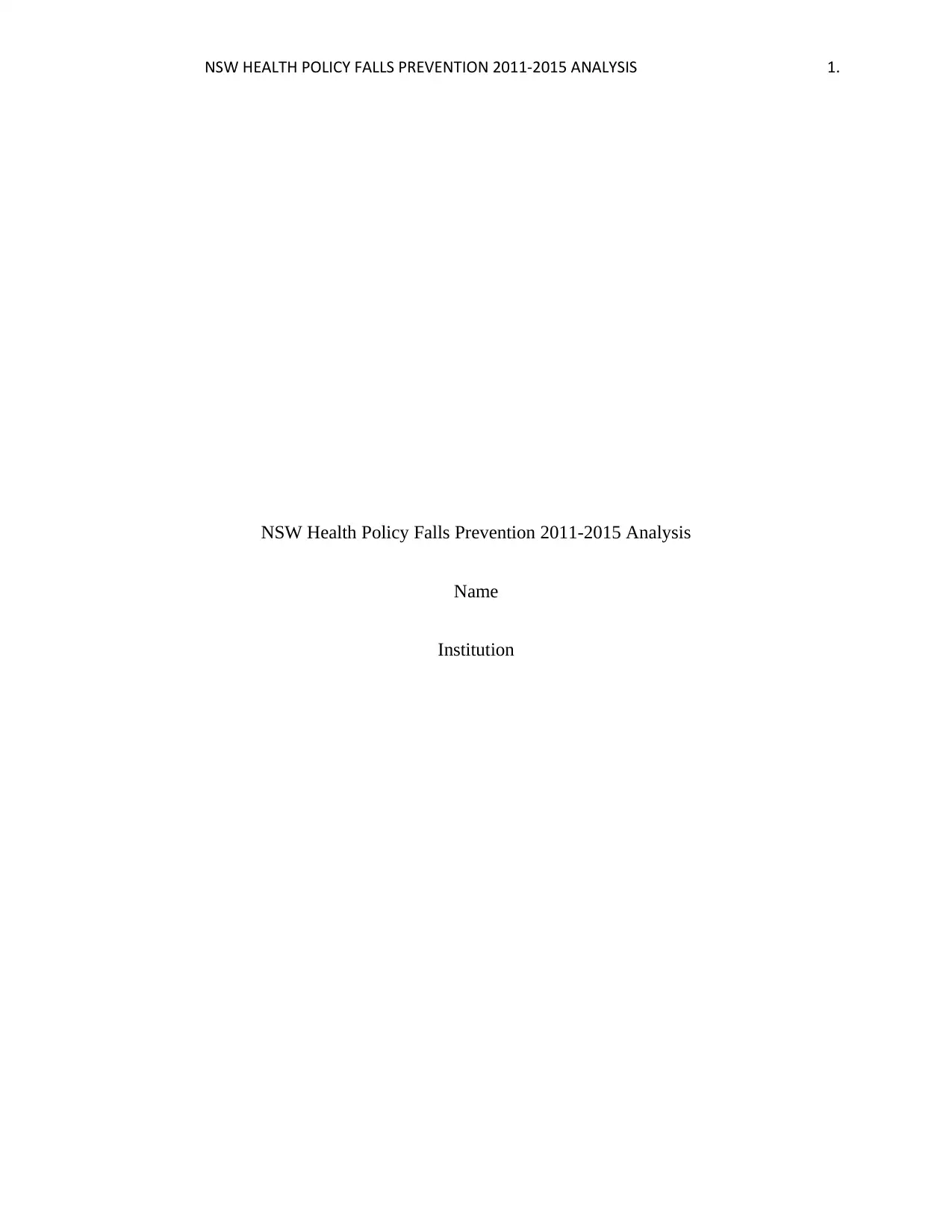
NSW HEALTH POLICY FALLS PREVENTION 2011-2015 ANALYSIS 1.
NSW Health Policy Falls Prevention 2011-2015 Analysis
Name
Institution
NSW Health Policy Falls Prevention 2011-2015 Analysis
Name
Institution
Paraphrase This Document
Need a fresh take? Get an instant paraphrase of this document with our AI Paraphraser
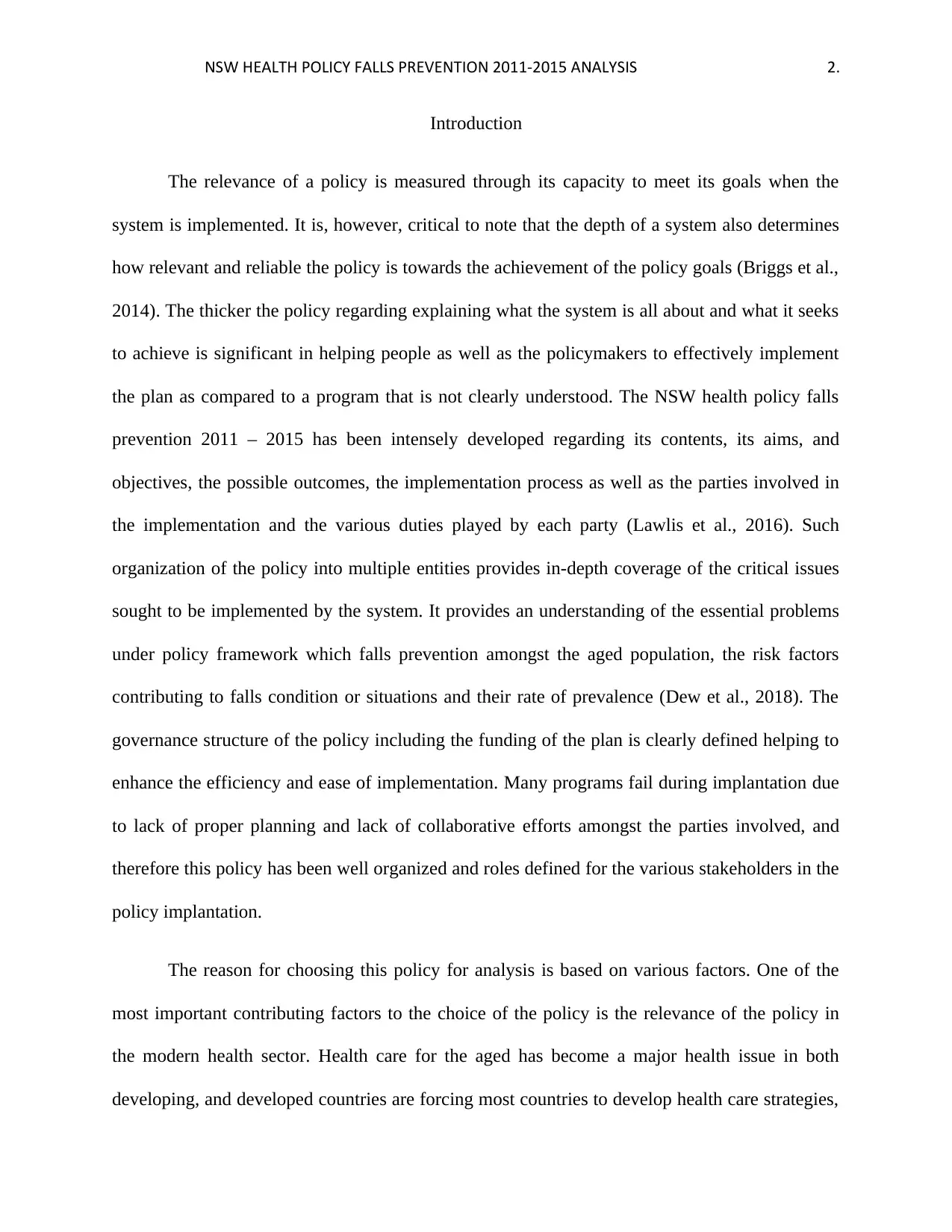
NSW HEALTH POLICY FALLS PREVENTION 2011-2015 ANALYSIS 2.
Introduction
The relevance of a policy is measured through its capacity to meet its goals when the
system is implemented. It is, however, critical to note that the depth of a system also determines
how relevant and reliable the policy is towards the achievement of the policy goals (Briggs et al.,
2014). The thicker the policy regarding explaining what the system is all about and what it seeks
to achieve is significant in helping people as well as the policymakers to effectively implement
the plan as compared to a program that is not clearly understood. The NSW health policy falls
prevention 2011 – 2015 has been intensely developed regarding its contents, its aims, and
objectives, the possible outcomes, the implementation process as well as the parties involved in
the implementation and the various duties played by each party (Lawlis et al., 2016). Such
organization of the policy into multiple entities provides in-depth coverage of the critical issues
sought to be implemented by the system. It provides an understanding of the essential problems
under policy framework which falls prevention amongst the aged population, the risk factors
contributing to falls condition or situations and their rate of prevalence (Dew et al., 2018). The
governance structure of the policy including the funding of the plan is clearly defined helping to
enhance the efficiency and ease of implementation. Many programs fail during implantation due
to lack of proper planning and lack of collaborative efforts amongst the parties involved, and
therefore this policy has been well organized and roles defined for the various stakeholders in the
policy implantation.
The reason for choosing this policy for analysis is based on various factors. One of the
most important contributing factors to the choice of the policy is the relevance of the policy in
the modern health sector. Health care for the aged has become a major health issue in both
developing, and developed countries are forcing most countries to develop health care strategies,
Introduction
The relevance of a policy is measured through its capacity to meet its goals when the
system is implemented. It is, however, critical to note that the depth of a system also determines
how relevant and reliable the policy is towards the achievement of the policy goals (Briggs et al.,
2014). The thicker the policy regarding explaining what the system is all about and what it seeks
to achieve is significant in helping people as well as the policymakers to effectively implement
the plan as compared to a program that is not clearly understood. The NSW health policy falls
prevention 2011 – 2015 has been intensely developed regarding its contents, its aims, and
objectives, the possible outcomes, the implementation process as well as the parties involved in
the implementation and the various duties played by each party (Lawlis et al., 2016). Such
organization of the policy into multiple entities provides in-depth coverage of the critical issues
sought to be implemented by the system. It provides an understanding of the essential problems
under policy framework which falls prevention amongst the aged population, the risk factors
contributing to falls condition or situations and their rate of prevalence (Dew et al., 2018). The
governance structure of the policy including the funding of the plan is clearly defined helping to
enhance the efficiency and ease of implementation. Many programs fail during implantation due
to lack of proper planning and lack of collaborative efforts amongst the parties involved, and
therefore this policy has been well organized and roles defined for the various stakeholders in the
policy implantation.
The reason for choosing this policy for analysis is based on various factors. One of the
most important contributing factors to the choice of the policy is the relevance of the policy in
the modern health sector. Health care for the aged has become a major health issue in both
developing, and developed countries are forcing most countries to develop health care strategies,
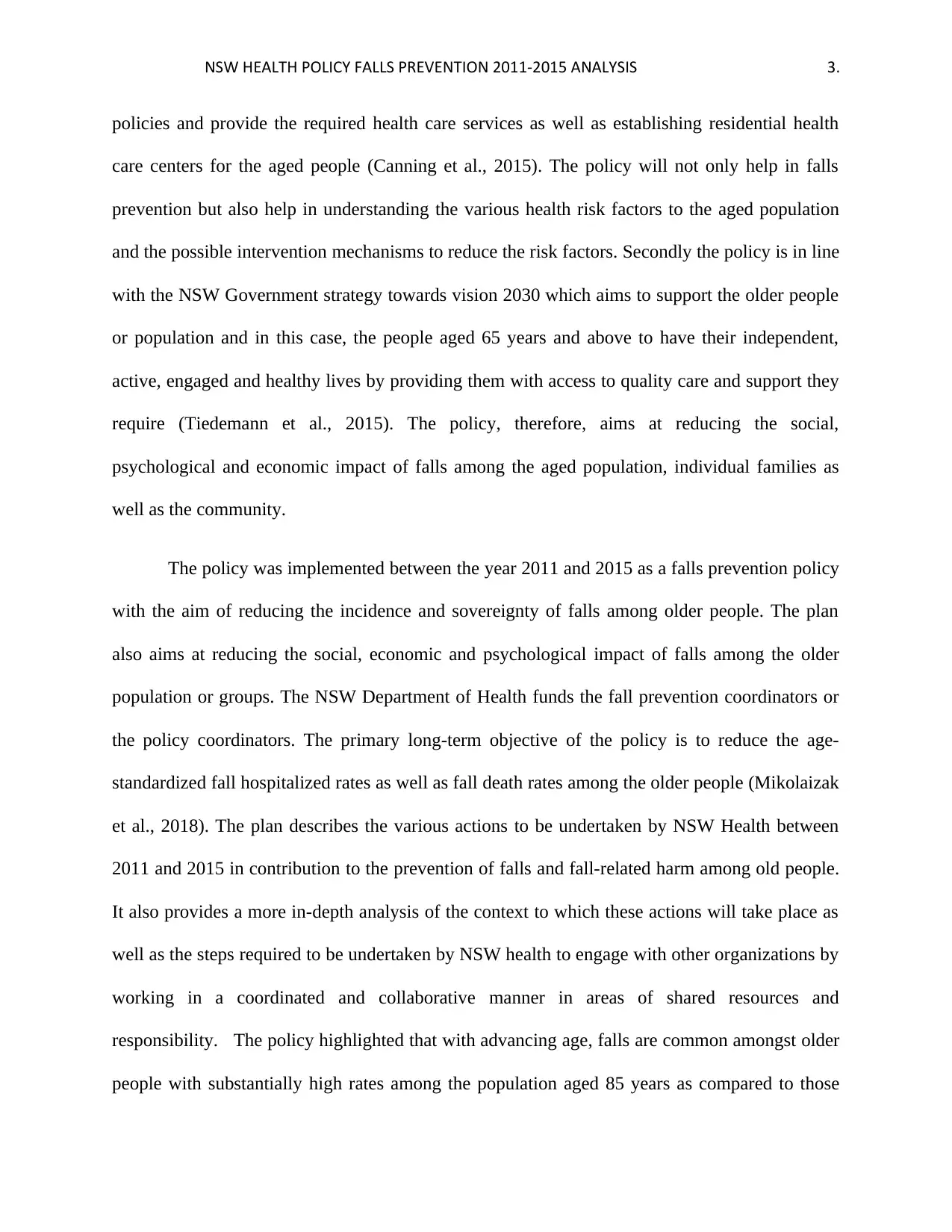
NSW HEALTH POLICY FALLS PREVENTION 2011-2015 ANALYSIS 3.
policies and provide the required health care services as well as establishing residential health
care centers for the aged people (Canning et al., 2015). The policy will not only help in falls
prevention but also help in understanding the various health risk factors to the aged population
and the possible intervention mechanisms to reduce the risk factors. Secondly the policy is in line
with the NSW Government strategy towards vision 2030 which aims to support the older people
or population and in this case, the people aged 65 years and above to have their independent,
active, engaged and healthy lives by providing them with access to quality care and support they
require (Tiedemann et al., 2015). The policy, therefore, aims at reducing the social,
psychological and economic impact of falls among the aged population, individual families as
well as the community.
The policy was implemented between the year 2011 and 2015 as a falls prevention policy
with the aim of reducing the incidence and sovereignty of falls among older people. The plan
also aims at reducing the social, economic and psychological impact of falls among the older
population or groups. The NSW Department of Health funds the fall prevention coordinators or
the policy coordinators. The primary long-term objective of the policy is to reduce the age-
standardized fall hospitalized rates as well as fall death rates among the older people (Mikolaizak
et al., 2018). The plan describes the various actions to be undertaken by NSW Health between
2011 and 2015 in contribution to the prevention of falls and fall-related harm among old people.
It also provides a more in-depth analysis of the context to which these actions will take place as
well as the steps required to be undertaken by NSW health to engage with other organizations by
working in a coordinated and collaborative manner in areas of shared resources and
responsibility. The policy highlighted that with advancing age, falls are common amongst older
people with substantially high rates among the population aged 85 years as compared to those
policies and provide the required health care services as well as establishing residential health
care centers for the aged people (Canning et al., 2015). The policy will not only help in falls
prevention but also help in understanding the various health risk factors to the aged population
and the possible intervention mechanisms to reduce the risk factors. Secondly the policy is in line
with the NSW Government strategy towards vision 2030 which aims to support the older people
or population and in this case, the people aged 65 years and above to have their independent,
active, engaged and healthy lives by providing them with access to quality care and support they
require (Tiedemann et al., 2015). The policy, therefore, aims at reducing the social,
psychological and economic impact of falls among the aged population, individual families as
well as the community.
The policy was implemented between the year 2011 and 2015 as a falls prevention policy
with the aim of reducing the incidence and sovereignty of falls among older people. The plan
also aims at reducing the social, economic and psychological impact of falls among the older
population or groups. The NSW Department of Health funds the fall prevention coordinators or
the policy coordinators. The primary long-term objective of the policy is to reduce the age-
standardized fall hospitalized rates as well as fall death rates among the older people (Mikolaizak
et al., 2018). The plan describes the various actions to be undertaken by NSW Health between
2011 and 2015 in contribution to the prevention of falls and fall-related harm among old people.
It also provides a more in-depth analysis of the context to which these actions will take place as
well as the steps required to be undertaken by NSW health to engage with other organizations by
working in a coordinated and collaborative manner in areas of shared resources and
responsibility. The policy highlighted that with advancing age, falls are common amongst older
people with substantially high rates among the population aged 85 years as compared to those
⊘ This is a preview!⊘
Do you want full access?
Subscribe today to unlock all pages.

Trusted by 1+ million students worldwide
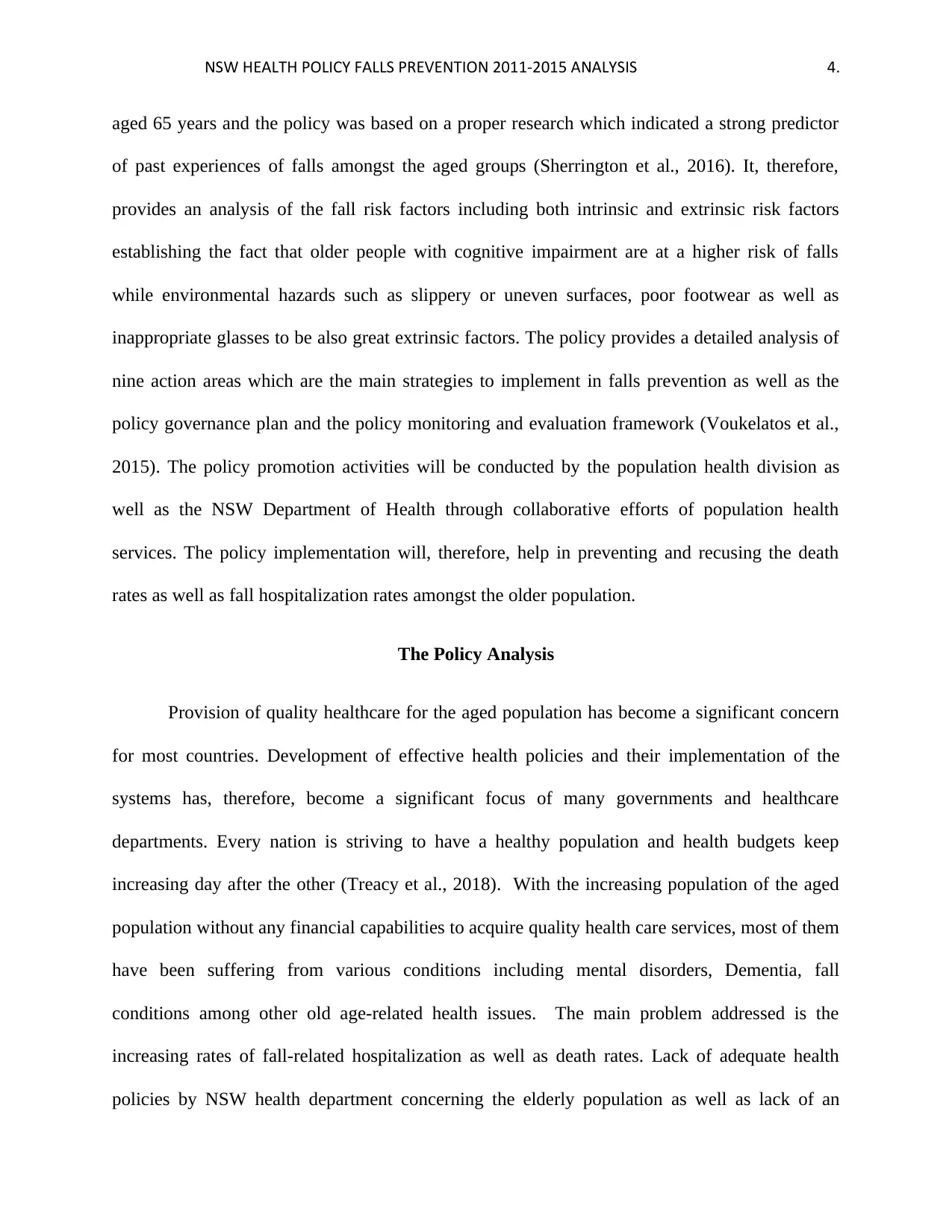
NSW HEALTH POLICY FALLS PREVENTION 2011-2015 ANALYSIS 4.
aged 65 years and the policy was based on a proper research which indicated a strong predictor
of past experiences of falls amongst the aged groups (Sherrington et al., 2016). It, therefore,
provides an analysis of the fall risk factors including both intrinsic and extrinsic risk factors
establishing the fact that older people with cognitive impairment are at a higher risk of falls
while environmental hazards such as slippery or uneven surfaces, poor footwear as well as
inappropriate glasses to be also great extrinsic factors. The policy provides a detailed analysis of
nine action areas which are the main strategies to implement in falls prevention as well as the
policy governance plan and the policy monitoring and evaluation framework (Voukelatos et al.,
2015). The policy promotion activities will be conducted by the population health division as
well as the NSW Department of Health through collaborative efforts of population health
services. The policy implementation will, therefore, help in preventing and recusing the death
rates as well as fall hospitalization rates amongst the older population.
The Policy Analysis
Provision of quality healthcare for the aged population has become a significant concern
for most countries. Development of effective health policies and their implementation of the
systems has, therefore, become a significant focus of many governments and healthcare
departments. Every nation is striving to have a healthy population and health budgets keep
increasing day after the other (Treacy et al., 2018). With the increasing population of the aged
population without any financial capabilities to acquire quality health care services, most of them
have been suffering from various conditions including mental disorders, Dementia, fall
conditions among other old age-related health issues. The main problem addressed is the
increasing rates of fall-related hospitalization as well as death rates. Lack of adequate health
policies by NSW health department concerning the elderly population as well as lack of an
aged 65 years and the policy was based on a proper research which indicated a strong predictor
of past experiences of falls amongst the aged groups (Sherrington et al., 2016). It, therefore,
provides an analysis of the fall risk factors including both intrinsic and extrinsic risk factors
establishing the fact that older people with cognitive impairment are at a higher risk of falls
while environmental hazards such as slippery or uneven surfaces, poor footwear as well as
inappropriate glasses to be also great extrinsic factors. The policy provides a detailed analysis of
nine action areas which are the main strategies to implement in falls prevention as well as the
policy governance plan and the policy monitoring and evaluation framework (Voukelatos et al.,
2015). The policy promotion activities will be conducted by the population health division as
well as the NSW Department of Health through collaborative efforts of population health
services. The policy implementation will, therefore, help in preventing and recusing the death
rates as well as fall hospitalization rates amongst the older population.
The Policy Analysis
Provision of quality healthcare for the aged population has become a significant concern
for most countries. Development of effective health policies and their implementation of the
systems has, therefore, become a significant focus of many governments and healthcare
departments. Every nation is striving to have a healthy population and health budgets keep
increasing day after the other (Treacy et al., 2018). With the increasing population of the aged
population without any financial capabilities to acquire quality health care services, most of them
have been suffering from various conditions including mental disorders, Dementia, fall
conditions among other old age-related health issues. The main problem addressed is the
increasing rates of fall-related hospitalization as well as death rates. Lack of adequate health
policies by NSW health department concerning the elderly population as well as lack of an
Paraphrase This Document
Need a fresh take? Get an instant paraphrase of this document with our AI Paraphraser
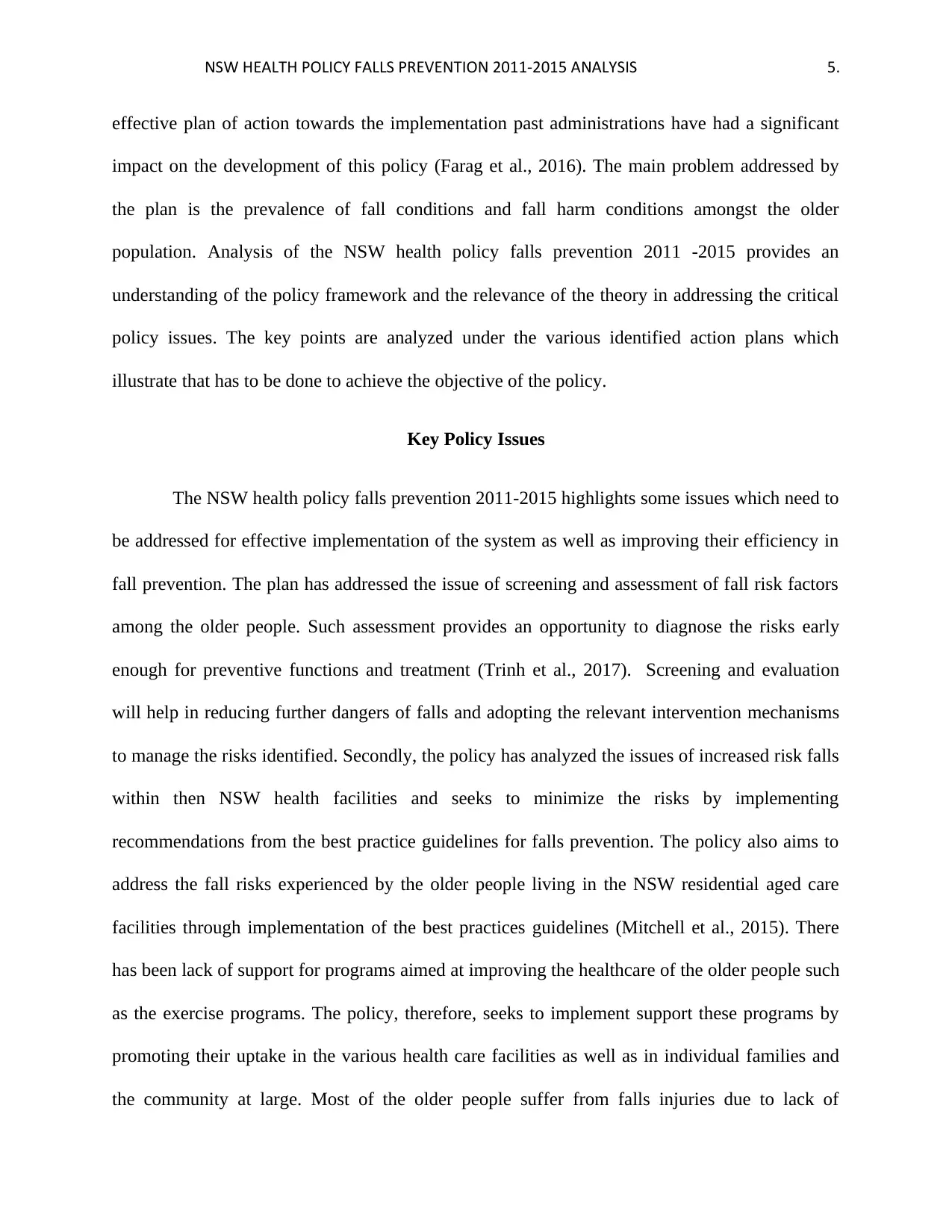
NSW HEALTH POLICY FALLS PREVENTION 2011-2015 ANALYSIS 5.
effective plan of action towards the implementation past administrations have had a significant
impact on the development of this policy (Farag et al., 2016). The main problem addressed by
the plan is the prevalence of fall conditions and fall harm conditions amongst the older
population. Analysis of the NSW health policy falls prevention 2011 -2015 provides an
understanding of the policy framework and the relevance of the theory in addressing the critical
policy issues. The key points are analyzed under the various identified action plans which
illustrate that has to be done to achieve the objective of the policy.
Key Policy Issues
The NSW health policy falls prevention 2011-2015 highlights some issues which need to
be addressed for effective implementation of the system as well as improving their efficiency in
fall prevention. The plan has addressed the issue of screening and assessment of fall risk factors
among the older people. Such assessment provides an opportunity to diagnose the risks early
enough for preventive functions and treatment (Trinh et al., 2017). Screening and evaluation
will help in reducing further dangers of falls and adopting the relevant intervention mechanisms
to manage the risks identified. Secondly, the policy has analyzed the issues of increased risk falls
within then NSW health facilities and seeks to minimize the risks by implementing
recommendations from the best practice guidelines for falls prevention. The policy also aims to
address the fall risks experienced by the older people living in the NSW residential aged care
facilities through implementation of the best practices guidelines (Mitchell et al., 2015). There
has been lack of support for programs aimed at improving the healthcare of the older people such
as the exercise programs. The policy, therefore, seeks to implement support these programs by
promoting their uptake in the various health care facilities as well as in individual families and
the community at large. Most of the older people suffer from falls injuries due to lack of
effective plan of action towards the implementation past administrations have had a significant
impact on the development of this policy (Farag et al., 2016). The main problem addressed by
the plan is the prevalence of fall conditions and fall harm conditions amongst the older
population. Analysis of the NSW health policy falls prevention 2011 -2015 provides an
understanding of the policy framework and the relevance of the theory in addressing the critical
policy issues. The key points are analyzed under the various identified action plans which
illustrate that has to be done to achieve the objective of the policy.
Key Policy Issues
The NSW health policy falls prevention 2011-2015 highlights some issues which need to
be addressed for effective implementation of the system as well as improving their efficiency in
fall prevention. The plan has addressed the issue of screening and assessment of fall risk factors
among the older people. Such assessment provides an opportunity to diagnose the risks early
enough for preventive functions and treatment (Trinh et al., 2017). Screening and evaluation
will help in reducing further dangers of falls and adopting the relevant intervention mechanisms
to manage the risks identified. Secondly, the policy has analyzed the issues of increased risk falls
within then NSW health facilities and seeks to minimize the risks by implementing
recommendations from the best practice guidelines for falls prevention. The policy also aims to
address the fall risks experienced by the older people living in the NSW residential aged care
facilities through implementation of the best practices guidelines (Mitchell et al., 2015). There
has been lack of support for programs aimed at improving the healthcare of the older people such
as the exercise programs. The policy, therefore, seeks to implement support these programs by
promoting their uptake in the various health care facilities as well as in individual families and
the community at large. Most of the older people suffer from falls injuries due to lack of
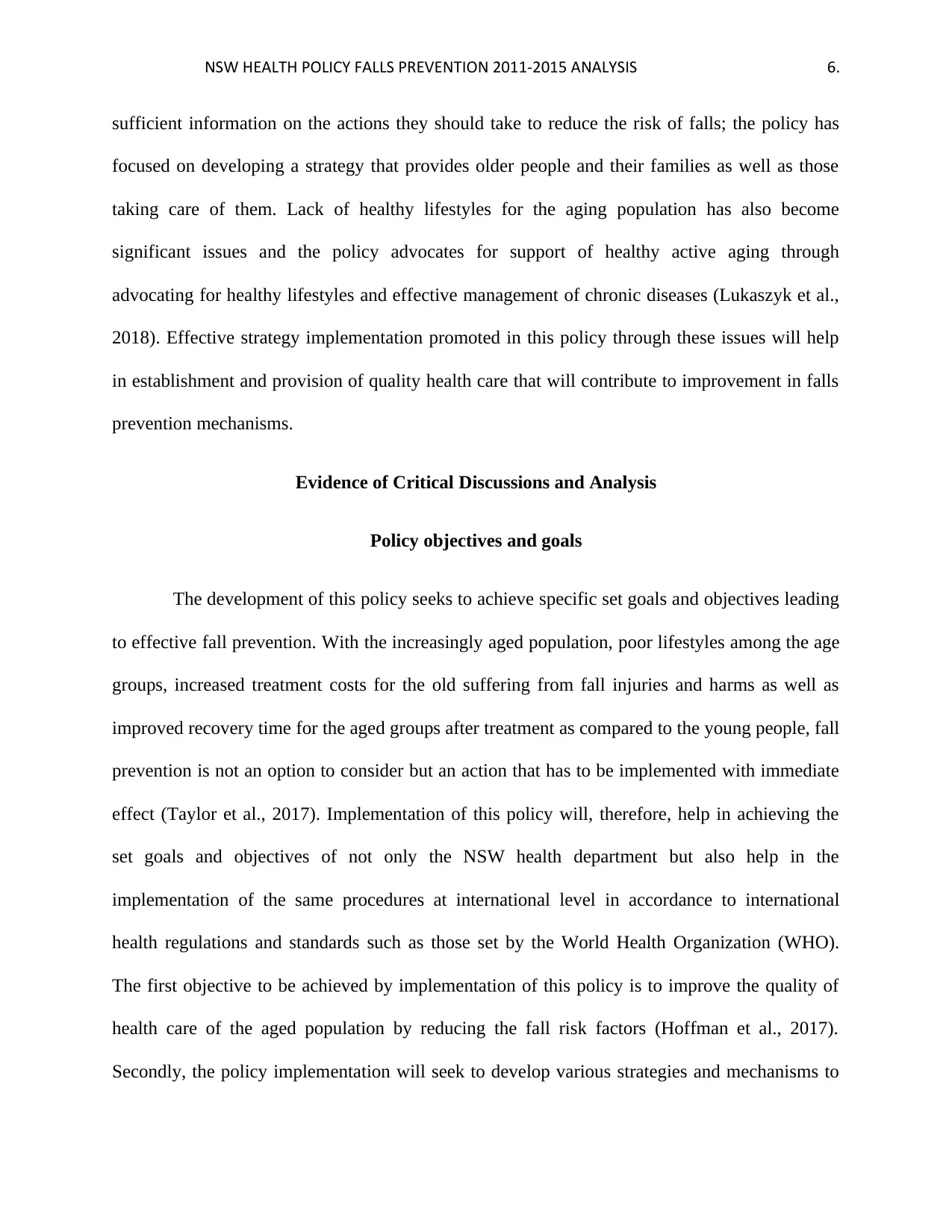
NSW HEALTH POLICY FALLS PREVENTION 2011-2015 ANALYSIS 6.
sufficient information on the actions they should take to reduce the risk of falls; the policy has
focused on developing a strategy that provides older people and their families as well as those
taking care of them. Lack of healthy lifestyles for the aging population has also become
significant issues and the policy advocates for support of healthy active aging through
advocating for healthy lifestyles and effective management of chronic diseases (Lukaszyk et al.,
2018). Effective strategy implementation promoted in this policy through these issues will help
in establishment and provision of quality health care that will contribute to improvement in falls
prevention mechanisms.
Evidence of Critical Discussions and Analysis
Policy objectives and goals
The development of this policy seeks to achieve specific set goals and objectives leading
to effective fall prevention. With the increasingly aged population, poor lifestyles among the age
groups, increased treatment costs for the old suffering from fall injuries and harms as well as
improved recovery time for the aged groups after treatment as compared to the young people, fall
prevention is not an option to consider but an action that has to be implemented with immediate
effect (Taylor et al., 2017). Implementation of this policy will, therefore, help in achieving the
set goals and objectives of not only the NSW health department but also help in the
implementation of the same procedures at international level in accordance to international
health regulations and standards such as those set by the World Health Organization (WHO).
The first objective to be achieved by implementation of this policy is to improve the quality of
health care of the aged population by reducing the fall risk factors (Hoffman et al., 2017).
Secondly, the policy implementation will seek to develop various strategies and mechanisms to
sufficient information on the actions they should take to reduce the risk of falls; the policy has
focused on developing a strategy that provides older people and their families as well as those
taking care of them. Lack of healthy lifestyles for the aging population has also become
significant issues and the policy advocates for support of healthy active aging through
advocating for healthy lifestyles and effective management of chronic diseases (Lukaszyk et al.,
2018). Effective strategy implementation promoted in this policy through these issues will help
in establishment and provision of quality health care that will contribute to improvement in falls
prevention mechanisms.
Evidence of Critical Discussions and Analysis
Policy objectives and goals
The development of this policy seeks to achieve specific set goals and objectives leading
to effective fall prevention. With the increasingly aged population, poor lifestyles among the age
groups, increased treatment costs for the old suffering from fall injuries and harms as well as
improved recovery time for the aged groups after treatment as compared to the young people, fall
prevention is not an option to consider but an action that has to be implemented with immediate
effect (Taylor et al., 2017). Implementation of this policy will, therefore, help in achieving the
set goals and objectives of not only the NSW health department but also help in the
implementation of the same procedures at international level in accordance to international
health regulations and standards such as those set by the World Health Organization (WHO).
The first objective to be achieved by implementation of this policy is to improve the quality of
health care of the aged population by reducing the fall risk factors (Hoffman et al., 2017).
Secondly, the policy implementation will seek to develop various strategies and mechanisms to
⊘ This is a preview!⊘
Do you want full access?
Subscribe today to unlock all pages.

Trusted by 1+ million students worldwide
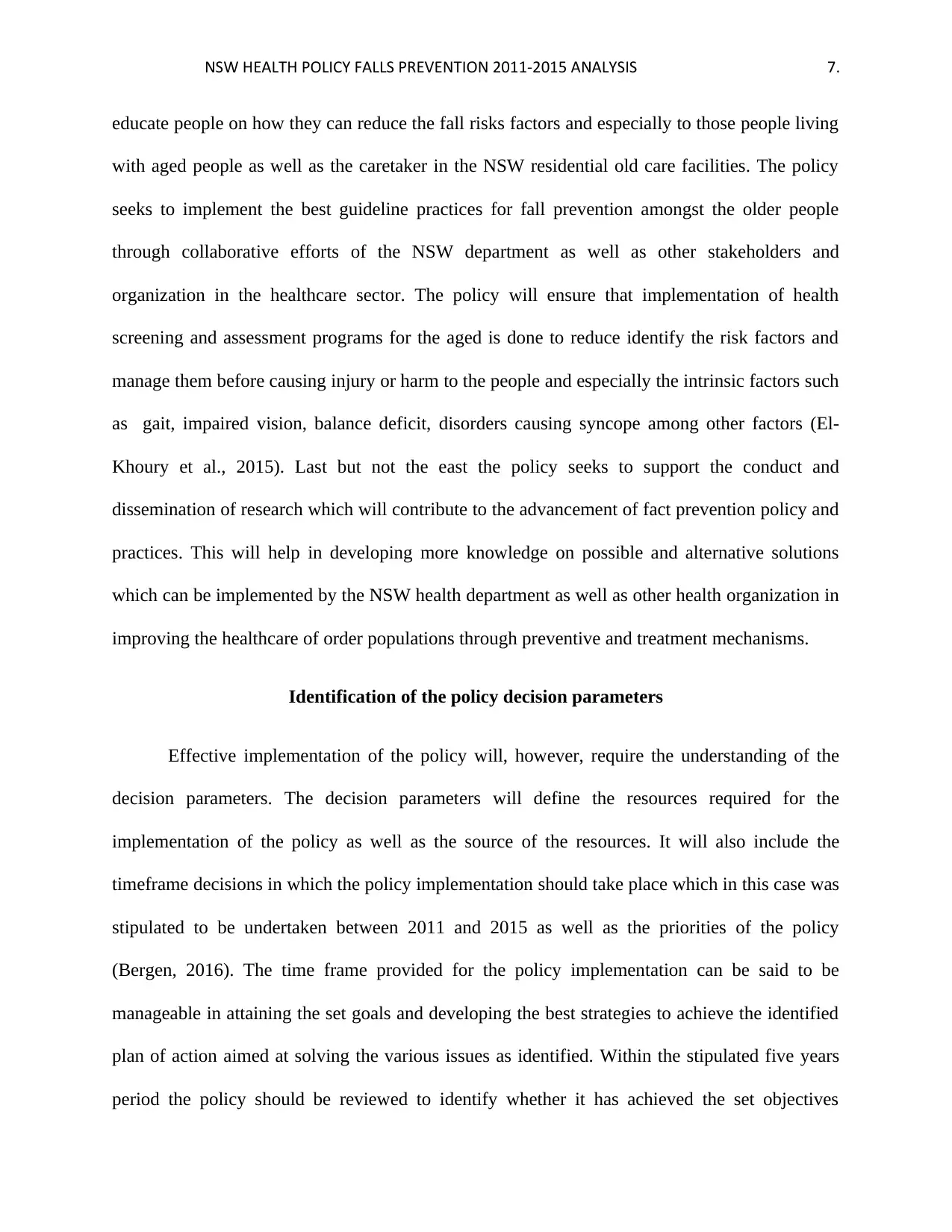
NSW HEALTH POLICY FALLS PREVENTION 2011-2015 ANALYSIS 7.
educate people on how they can reduce the fall risks factors and especially to those people living
with aged people as well as the caretaker in the NSW residential old care facilities. The policy
seeks to implement the best guideline practices for fall prevention amongst the older people
through collaborative efforts of the NSW department as well as other stakeholders and
organization in the healthcare sector. The policy will ensure that implementation of health
screening and assessment programs for the aged is done to reduce identify the risk factors and
manage them before causing injury or harm to the people and especially the intrinsic factors such
as gait, impaired vision, balance deficit, disorders causing syncope among other factors (El-
Khoury et al., 2015). Last but not the east the policy seeks to support the conduct and
dissemination of research which will contribute to the advancement of fact prevention policy and
practices. This will help in developing more knowledge on possible and alternative solutions
which can be implemented by the NSW health department as well as other health organization in
improving the healthcare of order populations through preventive and treatment mechanisms.
Identification of the policy decision parameters
Effective implementation of the policy will, however, require the understanding of the
decision parameters. The decision parameters will define the resources required for the
implementation of the policy as well as the source of the resources. It will also include the
timeframe decisions in which the policy implementation should take place which in this case was
stipulated to be undertaken between 2011 and 2015 as well as the priorities of the policy
(Bergen, 2016). The time frame provided for the policy implementation can be said to be
manageable in attaining the set goals and developing the best strategies to achieve the identified
plan of action aimed at solving the various issues as identified. Within the stipulated five years
period the policy should be reviewed to identify whether it has achieved the set objectives
educate people on how they can reduce the fall risks factors and especially to those people living
with aged people as well as the caretaker in the NSW residential old care facilities. The policy
seeks to implement the best guideline practices for fall prevention amongst the older people
through collaborative efforts of the NSW department as well as other stakeholders and
organization in the healthcare sector. The policy will ensure that implementation of health
screening and assessment programs for the aged is done to reduce identify the risk factors and
manage them before causing injury or harm to the people and especially the intrinsic factors such
as gait, impaired vision, balance deficit, disorders causing syncope among other factors (El-
Khoury et al., 2015). Last but not the east the policy seeks to support the conduct and
dissemination of research which will contribute to the advancement of fact prevention policy and
practices. This will help in developing more knowledge on possible and alternative solutions
which can be implemented by the NSW health department as well as other health organization in
improving the healthcare of order populations through preventive and treatment mechanisms.
Identification of the policy decision parameters
Effective implementation of the policy will, however, require the understanding of the
decision parameters. The decision parameters will define the resources required for the
implementation of the policy as well as the source of the resources. It will also include the
timeframe decisions in which the policy implementation should take place which in this case was
stipulated to be undertaken between 2011 and 2015 as well as the priorities of the policy
(Bergen, 2016). The time frame provided for the policy implementation can be said to be
manageable in attaining the set goals and developing the best strategies to achieve the identified
plan of action aimed at solving the various issues as identified. Within the stipulated five years
period the policy should be reviewed to identify whether it has achieved the set objectives
Paraphrase This Document
Need a fresh take? Get an instant paraphrase of this document with our AI Paraphraser
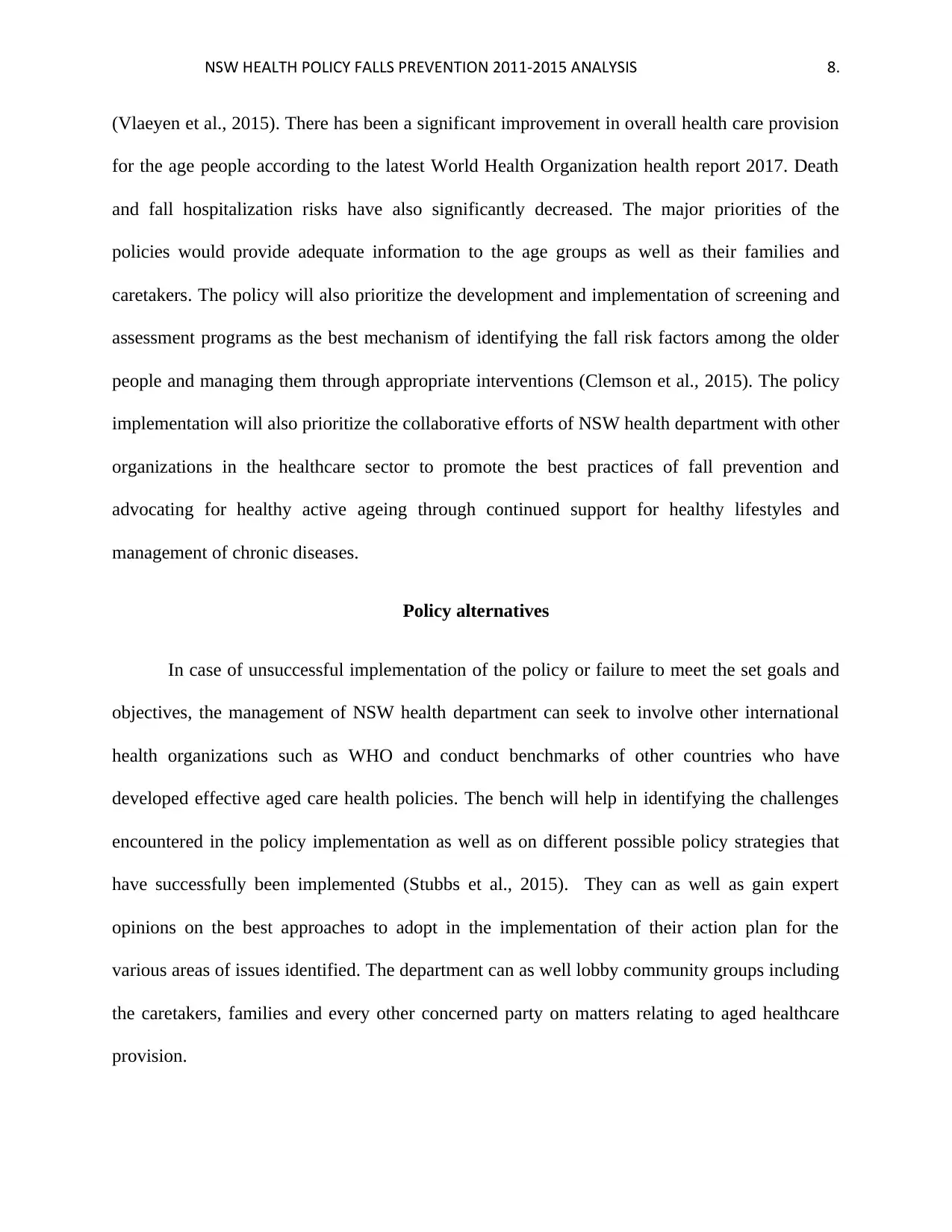
NSW HEALTH POLICY FALLS PREVENTION 2011-2015 ANALYSIS 8.
(Vlaeyen et al., 2015). There has been a significant improvement in overall health care provision
for the age people according to the latest World Health Organization health report 2017. Death
and fall hospitalization risks have also significantly decreased. The major priorities of the
policies would provide adequate information to the age groups as well as their families and
caretakers. The policy will also prioritize the development and implementation of screening and
assessment programs as the best mechanism of identifying the fall risk factors among the older
people and managing them through appropriate interventions (Clemson et al., 2015). The policy
implementation will also prioritize the collaborative efforts of NSW health department with other
organizations in the healthcare sector to promote the best practices of fall prevention and
advocating for healthy active ageing through continued support for healthy lifestyles and
management of chronic diseases.
Policy alternatives
In case of unsuccessful implementation of the policy or failure to meet the set goals and
objectives, the management of NSW health department can seek to involve other international
health organizations such as WHO and conduct benchmarks of other countries who have
developed effective aged care health policies. The bench will help in identifying the challenges
encountered in the policy implementation as well as on different possible policy strategies that
have successfully been implemented (Stubbs et al., 2015). They can as well as gain expert
opinions on the best approaches to adopt in the implementation of their action plan for the
various areas of issues identified. The department can as well lobby community groups including
the caretakers, families and every other concerned party on matters relating to aged healthcare
provision.
(Vlaeyen et al., 2015). There has been a significant improvement in overall health care provision
for the age people according to the latest World Health Organization health report 2017. Death
and fall hospitalization risks have also significantly decreased. The major priorities of the
policies would provide adequate information to the age groups as well as their families and
caretakers. The policy will also prioritize the development and implementation of screening and
assessment programs as the best mechanism of identifying the fall risk factors among the older
people and managing them through appropriate interventions (Clemson et al., 2015). The policy
implementation will also prioritize the collaborative efforts of NSW health department with other
organizations in the healthcare sector to promote the best practices of fall prevention and
advocating for healthy active ageing through continued support for healthy lifestyles and
management of chronic diseases.
Policy alternatives
In case of unsuccessful implementation of the policy or failure to meet the set goals and
objectives, the management of NSW health department can seek to involve other international
health organizations such as WHO and conduct benchmarks of other countries who have
developed effective aged care health policies. The bench will help in identifying the challenges
encountered in the policy implementation as well as on different possible policy strategies that
have successfully been implemented (Stubbs et al., 2015). They can as well as gain expert
opinions on the best approaches to adopt in the implementation of their action plan for the
various areas of issues identified. The department can as well lobby community groups including
the caretakers, families and every other concerned party on matters relating to aged healthcare
provision.
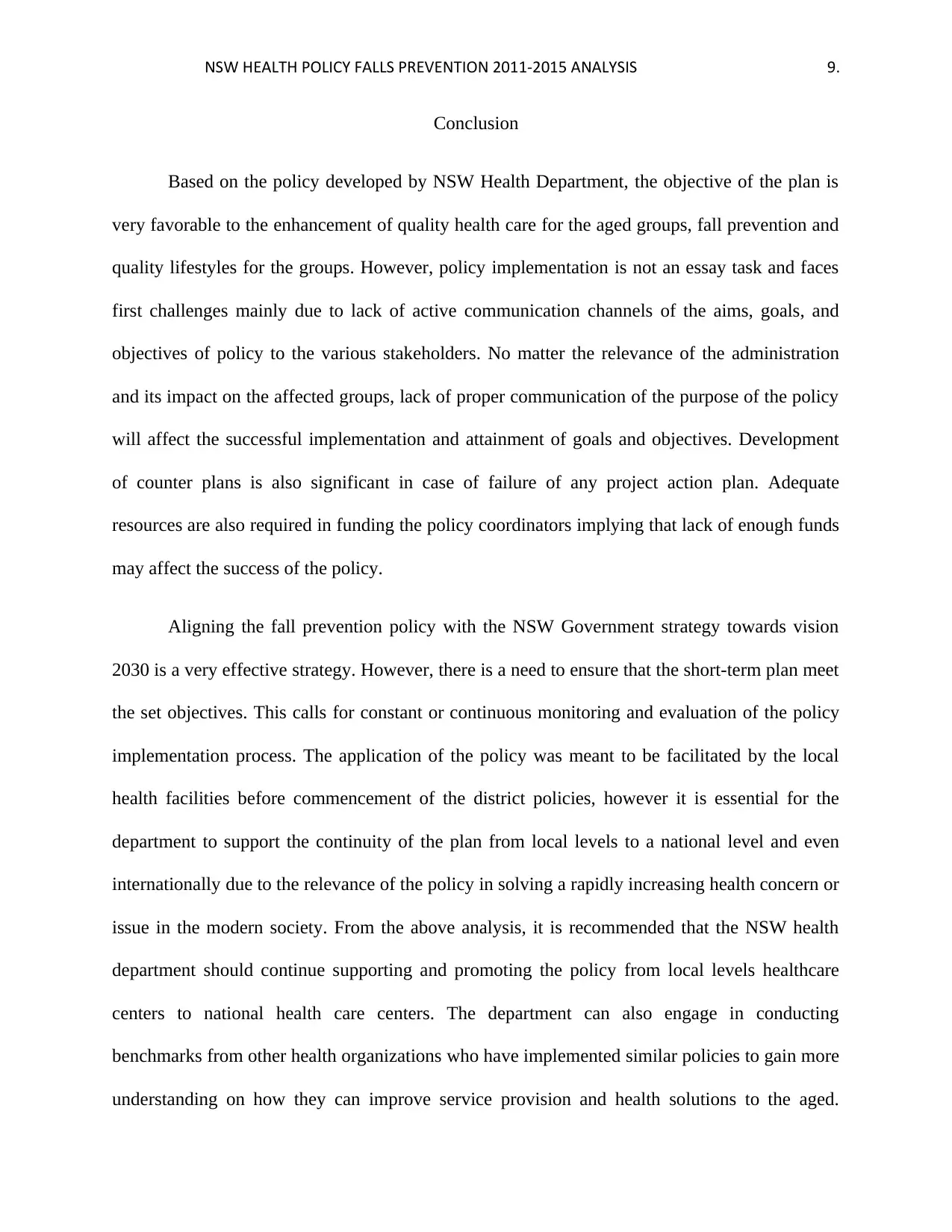
NSW HEALTH POLICY FALLS PREVENTION 2011-2015 ANALYSIS 9.
Conclusion
Based on the policy developed by NSW Health Department, the objective of the plan is
very favorable to the enhancement of quality health care for the aged groups, fall prevention and
quality lifestyles for the groups. However, policy implementation is not an essay task and faces
first challenges mainly due to lack of active communication channels of the aims, goals, and
objectives of policy to the various stakeholders. No matter the relevance of the administration
and its impact on the affected groups, lack of proper communication of the purpose of the policy
will affect the successful implementation and attainment of goals and objectives. Development
of counter plans is also significant in case of failure of any project action plan. Adequate
resources are also required in funding the policy coordinators implying that lack of enough funds
may affect the success of the policy.
Aligning the fall prevention policy with the NSW Government strategy towards vision
2030 is a very effective strategy. However, there is a need to ensure that the short-term plan meet
the set objectives. This calls for constant or continuous monitoring and evaluation of the policy
implementation process. The application of the policy was meant to be facilitated by the local
health facilities before commencement of the district policies, however it is essential for the
department to support the continuity of the plan from local levels to a national level and even
internationally due to the relevance of the policy in solving a rapidly increasing health concern or
issue in the modern society. From the above analysis, it is recommended that the NSW health
department should continue supporting and promoting the policy from local levels healthcare
centers to national health care centers. The department can also engage in conducting
benchmarks from other health organizations who have implemented similar policies to gain more
understanding on how they can improve service provision and health solutions to the aged.
Conclusion
Based on the policy developed by NSW Health Department, the objective of the plan is
very favorable to the enhancement of quality health care for the aged groups, fall prevention and
quality lifestyles for the groups. However, policy implementation is not an essay task and faces
first challenges mainly due to lack of active communication channels of the aims, goals, and
objectives of policy to the various stakeholders. No matter the relevance of the administration
and its impact on the affected groups, lack of proper communication of the purpose of the policy
will affect the successful implementation and attainment of goals and objectives. Development
of counter plans is also significant in case of failure of any project action plan. Adequate
resources are also required in funding the policy coordinators implying that lack of enough funds
may affect the success of the policy.
Aligning the fall prevention policy with the NSW Government strategy towards vision
2030 is a very effective strategy. However, there is a need to ensure that the short-term plan meet
the set objectives. This calls for constant or continuous monitoring and evaluation of the policy
implementation process. The application of the policy was meant to be facilitated by the local
health facilities before commencement of the district policies, however it is essential for the
department to support the continuity of the plan from local levels to a national level and even
internationally due to the relevance of the policy in solving a rapidly increasing health concern or
issue in the modern society. From the above analysis, it is recommended that the NSW health
department should continue supporting and promoting the policy from local levels healthcare
centers to national health care centers. The department can also engage in conducting
benchmarks from other health organizations who have implemented similar policies to gain more
understanding on how they can improve service provision and health solutions to the aged.
⊘ This is a preview!⊘
Do you want full access?
Subscribe today to unlock all pages.

Trusted by 1+ million students worldwide
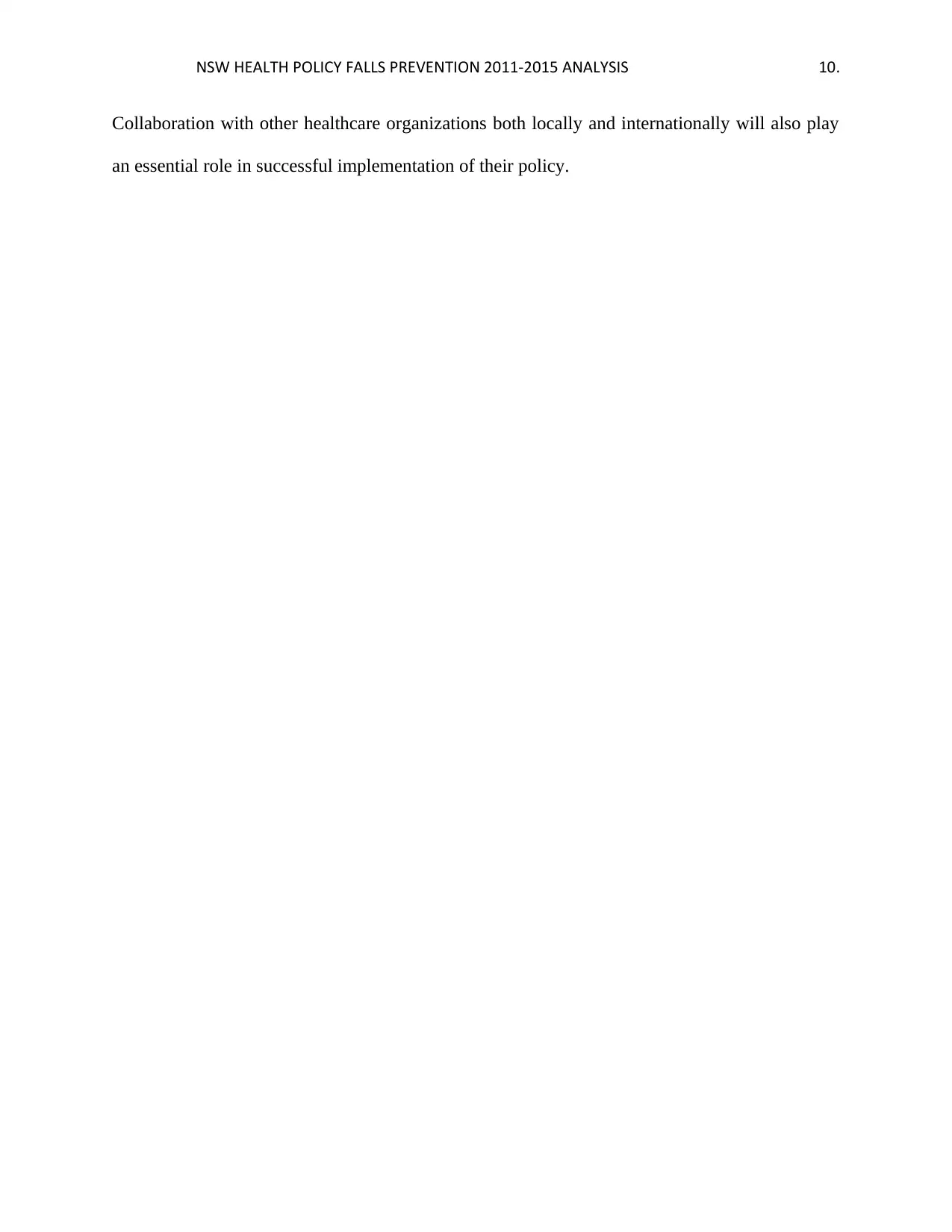
NSW HEALTH POLICY FALLS PREVENTION 2011-2015 ANALYSIS 10.
Collaboration with other healthcare organizations both locally and internationally will also play
an essential role in successful implementation of their policy.
Collaboration with other healthcare organizations both locally and internationally will also play
an essential role in successful implementation of their policy.
Paraphrase This Document
Need a fresh take? Get an instant paraphrase of this document with our AI Paraphraser
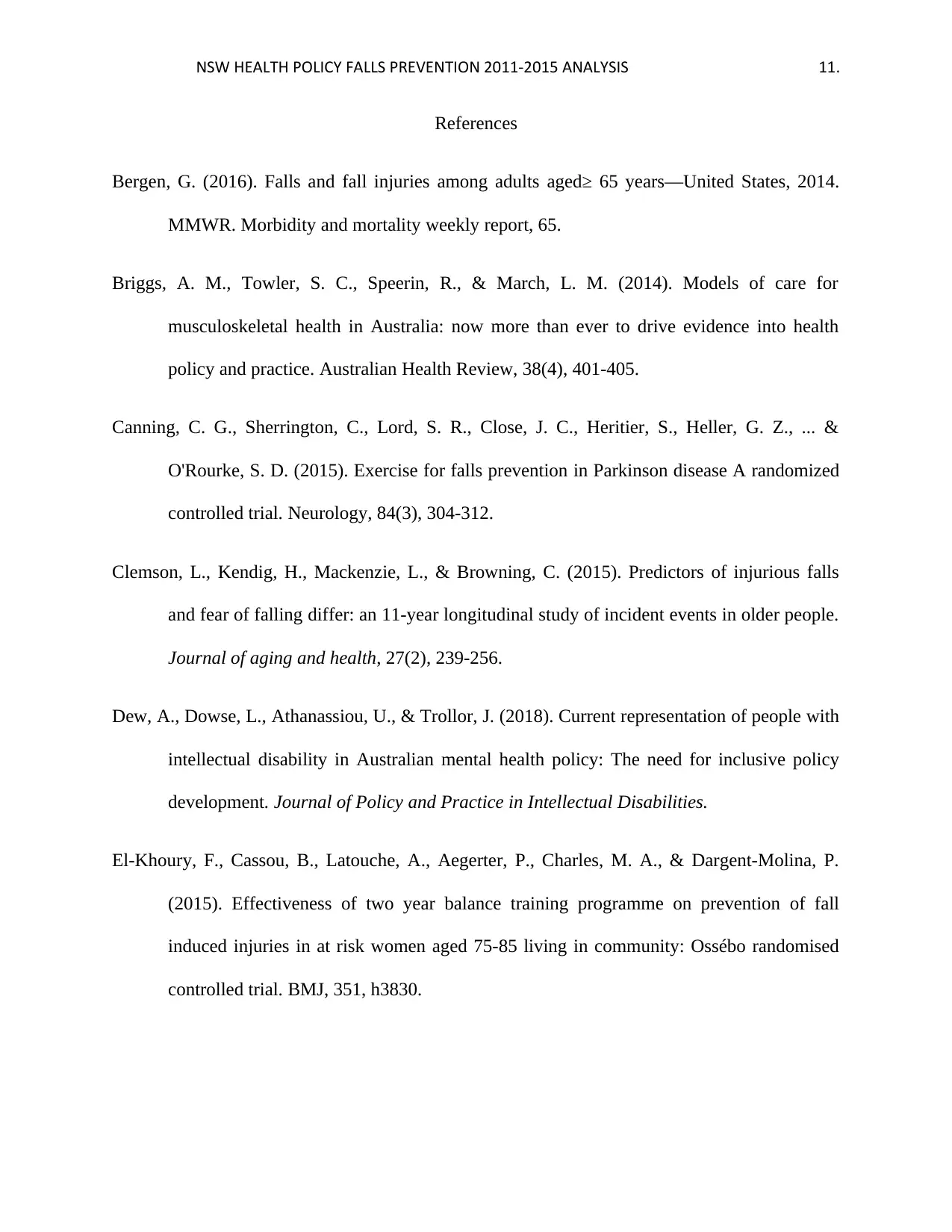
NSW HEALTH POLICY FALLS PREVENTION 2011-2015 ANALYSIS 11.
References
Bergen, G. (2016). Falls and fall injuries among adults aged≥ 65 years—United States, 2014.
MMWR. Morbidity and mortality weekly report, 65.
Briggs, A. M., Towler, S. C., Speerin, R., & March, L. M. (2014). Models of care for
musculoskeletal health in Australia: now more than ever to drive evidence into health
policy and practice. Australian Health Review, 38(4), 401-405.
Canning, C. G., Sherrington, C., Lord, S. R., Close, J. C., Heritier, S., Heller, G. Z., ... &
O'Rourke, S. D. (2015). Exercise for falls prevention in Parkinson disease A randomized
controlled trial. Neurology, 84(3), 304-312.
Clemson, L., Kendig, H., Mackenzie, L., & Browning, C. (2015). Predictors of injurious falls
and fear of falling differ: an 11-year longitudinal study of incident events in older people.
Journal of aging and health, 27(2), 239-256.
Dew, A., Dowse, L., Athanassiou, U., & Trollor, J. (2018). Current representation of people with
intellectual disability in Australian mental health policy: The need for inclusive policy
development. Journal of Policy and Practice in Intellectual Disabilities.
El-Khoury, F., Cassou, B., Latouche, A., Aegerter, P., Charles, M. A., & Dargent-Molina, P.
(2015). Effectiveness of two year balance training programme on prevention of fall
induced injuries in at risk women aged 75-85 living in community: Ossébo randomised
controlled trial. BMJ, 351, h3830.
References
Bergen, G. (2016). Falls and fall injuries among adults aged≥ 65 years—United States, 2014.
MMWR. Morbidity and mortality weekly report, 65.
Briggs, A. M., Towler, S. C., Speerin, R., & March, L. M. (2014). Models of care for
musculoskeletal health in Australia: now more than ever to drive evidence into health
policy and practice. Australian Health Review, 38(4), 401-405.
Canning, C. G., Sherrington, C., Lord, S. R., Close, J. C., Heritier, S., Heller, G. Z., ... &
O'Rourke, S. D. (2015). Exercise for falls prevention in Parkinson disease A randomized
controlled trial. Neurology, 84(3), 304-312.
Clemson, L., Kendig, H., Mackenzie, L., & Browning, C. (2015). Predictors of injurious falls
and fear of falling differ: an 11-year longitudinal study of incident events in older people.
Journal of aging and health, 27(2), 239-256.
Dew, A., Dowse, L., Athanassiou, U., & Trollor, J. (2018). Current representation of people with
intellectual disability in Australian mental health policy: The need for inclusive policy
development. Journal of Policy and Practice in Intellectual Disabilities.
El-Khoury, F., Cassou, B., Latouche, A., Aegerter, P., Charles, M. A., & Dargent-Molina, P.
(2015). Effectiveness of two year balance training programme on prevention of fall
induced injuries in at risk women aged 75-85 living in community: Ossébo randomised
controlled trial. BMJ, 351, h3830.
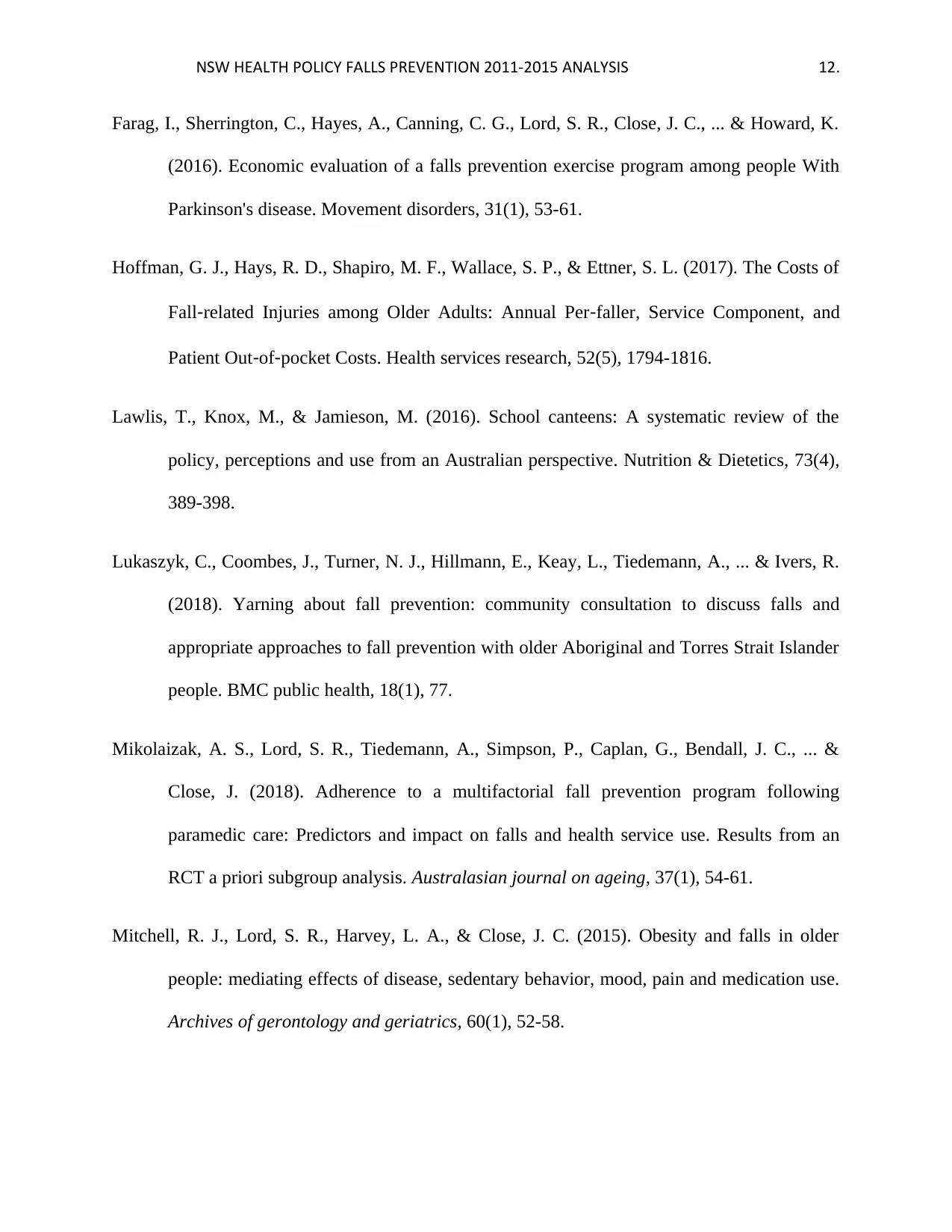
NSW HEALTH POLICY FALLS PREVENTION 2011-2015 ANALYSIS 12.
Farag, I., Sherrington, C., Hayes, A., Canning, C. G., Lord, S. R., Close, J. C., ... & Howard, K.
(2016). Economic evaluation of a falls prevention exercise program among people With
Parkinson's disease. Movement disorders, 31(1), 53-61.
Hoffman, G. J., Hays, R. D., Shapiro, M. F., Wallace, S. P., & Ettner, S. L. (2017). The Costs of
Fall‐related Injuries among Older Adults: Annual Per‐faller, Service Component, and
Patient Out‐of‐pocket Costs. Health services research, 52(5), 1794-1816.
Lawlis, T., Knox, M., & Jamieson, M. (2016). School canteens: A systematic review of the
policy, perceptions and use from an Australian perspective. Nutrition & Dietetics, 73(4),
389-398.
Lukaszyk, C., Coombes, J., Turner, N. J., Hillmann, E., Keay, L., Tiedemann, A., ... & Ivers, R.
(2018). Yarning about fall prevention: community consultation to discuss falls and
appropriate approaches to fall prevention with older Aboriginal and Torres Strait Islander
people. BMC public health, 18(1), 77.
Mikolaizak, A. S., Lord, S. R., Tiedemann, A., Simpson, P., Caplan, G., Bendall, J. C., ... &
Close, J. (2018). Adherence to a multifactorial fall prevention program following
paramedic care: Predictors and impact on falls and health service use. Results from an
RCT a priori subgroup analysis. Australasian journal on ageing, 37(1), 54-61.
Mitchell, R. J., Lord, S. R., Harvey, L. A., & Close, J. C. (2015). Obesity and falls in older
people: mediating effects of disease, sedentary behavior, mood, pain and medication use.
Archives of gerontology and geriatrics, 60(1), 52-58.
Farag, I., Sherrington, C., Hayes, A., Canning, C. G., Lord, S. R., Close, J. C., ... & Howard, K.
(2016). Economic evaluation of a falls prevention exercise program among people With
Parkinson's disease. Movement disorders, 31(1), 53-61.
Hoffman, G. J., Hays, R. D., Shapiro, M. F., Wallace, S. P., & Ettner, S. L. (2017). The Costs of
Fall‐related Injuries among Older Adults: Annual Per‐faller, Service Component, and
Patient Out‐of‐pocket Costs. Health services research, 52(5), 1794-1816.
Lawlis, T., Knox, M., & Jamieson, M. (2016). School canteens: A systematic review of the
policy, perceptions and use from an Australian perspective. Nutrition & Dietetics, 73(4),
389-398.
Lukaszyk, C., Coombes, J., Turner, N. J., Hillmann, E., Keay, L., Tiedemann, A., ... & Ivers, R.
(2018). Yarning about fall prevention: community consultation to discuss falls and
appropriate approaches to fall prevention with older Aboriginal and Torres Strait Islander
people. BMC public health, 18(1), 77.
Mikolaizak, A. S., Lord, S. R., Tiedemann, A., Simpson, P., Caplan, G., Bendall, J. C., ... &
Close, J. (2018). Adherence to a multifactorial fall prevention program following
paramedic care: Predictors and impact on falls and health service use. Results from an
RCT a priori subgroup analysis. Australasian journal on ageing, 37(1), 54-61.
Mitchell, R. J., Lord, S. R., Harvey, L. A., & Close, J. C. (2015). Obesity and falls in older
people: mediating effects of disease, sedentary behavior, mood, pain and medication use.
Archives of gerontology and geriatrics, 60(1), 52-58.
⊘ This is a preview!⊘
Do you want full access?
Subscribe today to unlock all pages.

Trusted by 1+ million students worldwide
1 out of 16
Related Documents
Your All-in-One AI-Powered Toolkit for Academic Success.
+13062052269
info@desklib.com
Available 24*7 on WhatsApp / Email
![[object Object]](/_next/static/media/star-bottom.7253800d.svg)
Unlock your academic potential
Copyright © 2020–2025 A2Z Services. All Rights Reserved. Developed and managed by ZUCOL.




